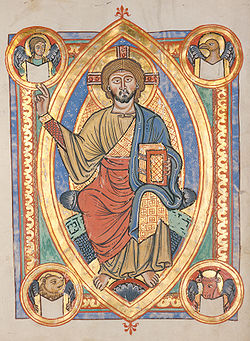Prayer before a crucifix
| Part of a series on |
| Devotions to Jesus in the Catholic Church |
|---|
 |
| Devotions |
| Prayers |
|
|
This article needs additional citations for verification. (July 2022) |
The topic of this article may not meet Wikipedia's general notability guideline. (July 2022) |
The prayer before a crucifix is a Roman Catholic prayer to Jesus. It is often said by Roman Catholics after Communion or after Mass. The faithful receive a partial indulgence if they recite the prayer after Communion before a crucifix. On the Fridays of Lent, the indulgence is a plenary indulgence.[1]
History
[edit]Throughout Christendom, believers have hung or painted a Christian cross, which they prostrated in front of, on the eastern wall of their home in order to indicate the eastward direction of prayer, as an "expression of their undying belief in the coming again of Jesus was united to their conviction that the cross, 'the sign of the Son of Man,' would appear in the eastern heavens on his return (see Matthew 24:30)."[2][3][4]
The original prayer dates to about 1205 and is commonly ascribed to Francis of Assisi while at San Damiano. The prayer echoes Psalm 22:17-18; it may also have been influenced by the opening prayer of the Eucharistic liturgy.[5]
Words of the prayer
[edit]
- Look down upon me, good and gentle Jesus,
- while before Thy face I humbly kneel and,
- with burning soul,
- pray and beseech Thee
- to fix deep in my heart lively sentiments
- of faith, hope and charity;
- true contrition for my sins,
- and a firm purpose of amendment.
- While I contemplate,
- with great love and tender pity,
- Thy five most precious wounds,
- pondering over them within me
- and calling to mind the words which David,
- Thy prophet, said of Thee, my Jesus:
- "They have pierced My hands and My feet,
- they have numbered all My bones."
- Amen.[6]
Alternative version
[edit]- Behold, O good and sweetest Jesus,
- I cast myself upon my knees in Thy sight,
- and with the most fervent desire of my soul
- I pray and beseech Thee
- to impress upon my heart
- lively sentiments of faith,
- hope and charity,
- with true repentance for my sins
- and a most firm desire of amendment.
- Whilst with deep affection and grief of soul
- I consider within myself
- and mentally contemplate
- Thy five most precious wounds,
- having before my eyes that which David,
- the prophet, long ago spoke concerning Thee,
- “They have pierced My hands and My feet,
- they have numbered all My bones.”
See also
[edit]References
[edit]- ^ "Manual of Indulgences" (PDF). Archived from the original (PDF) on 2022-09-09.
- ^ Kalleeny, Tony. "Why We Face the EAST". Orlando: St Mary and Archangel Michael Church. Retrieved 6 August 2020.
Christians in Syria as well, in the second century, would place the cross in the direction of the East towards which people in their homes or churches prayed. The direction to which Christians prayed symbolized their souls facing God, talking with him, and sharing their spirituality with the Lord.
- ^ Storey, William G. (2004). A Prayer Book of Catholic Devotions: Praying the Seasons and Feasts of the Church Year. Loyola Press. ISBN 978-0-8294-2030-2.
Long before Christians built churches for public prayer, they worshipped daily in their homes. In order to orient their prayer (to orient means literally "to turn toward the east"), they painted or hung a cross on the east wall of their main room. This practice was in keeping with ancient Jewish tradition ("Look toward the east, O Jerusalem," Baruch 4:36); Christians turned in that direction when they prayed morning and evening and at other times. This expression of their undying belief in the coming again of Jesus was united to their conviction that the cross, "the sign of the Son of Man," would appear in the eastern heavens on his return (see Matthew 24:30).
- ^ Johnson, Maxwell E. (2016). Between Memory and Hope: Readings on the Liturgical Year. Liturgical Press. ISBN 978-0-8146-6282-3.
Because Christ was expected to come from the east, Christians at a very early date prayed facing that direction in order to show themselves ready for his appearing, and actually looking forward to the great event which would consummate the union with him already experienced in prayer. For the same reason the sign of the cross was frequently traced on the eastern wall of places of prayer, thereby indicating the direction of prayer, but also rendering the Lord's coming a present reality in the sign which heralds it. In other words, through the cross the anticipated eschatological appearance becomes parousia: presence. The joining of prayer with the eschatological presence of Christ, unseen to the eye but revealed in the cross, obviously underlies the widely attested practice of prostrating before the sacred wood while praying to him who hung upon it.
- ^ "The Prayer before the Crucifix", Commission on the Franciscan Intellectual Tradition
- ^ "Prayer before a Crucifix". Catholic Online. Retrieved 2008-06-27.
- ^ Prayer before a Crucifix: Our Catholic Prayers

